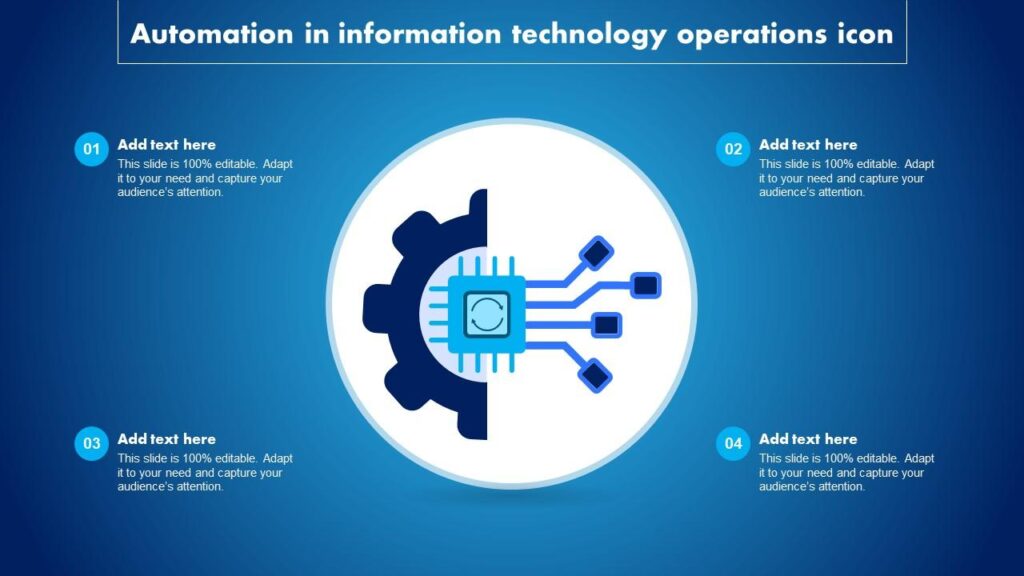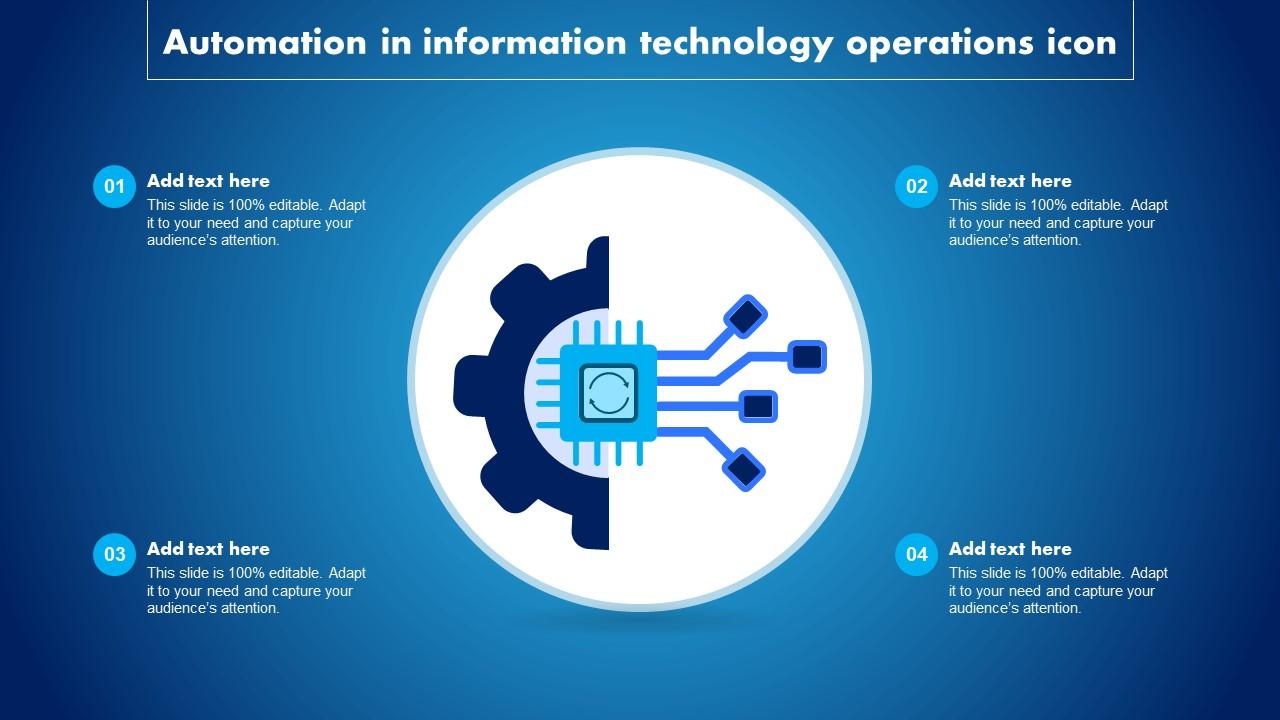1. Introduction to Automation in Information Technology
Automation in Information Technology (IT) refers to the use of technology to perform tasks that would traditionally require human intervention. This can include everything from software deployment and network management to cybersecurity and cloud infrastructure management. The evolution of automation technologies in IT has been remarkable. Starting with simple scripts and batch files in the early days, we now have sophisticated tools powered by artificial intelligence (AI) and machine learning (ML).

The significance of automation in today’s digital age cannot be overstated. Businesses are increasingly relying on IT automation to improve efficiency, reduce costs, and ensure consistent performance. By automating routine tasks, IT professionals can focus on more strategic initiatives that drive innovation and growth.
2. Benefits of Automation in IT
Enhancing Efficiency and Productivity:
Automation in Information Technology significantly streamlines processes and reduces manual effort. For example, automated software deployment tools can handle complex installation procedures in minutes, which would take hours if done manually. This leads to faster turnaround times and increased productivity across the board.
Reducing Human Error and Increasing Accuracy:
One of the biggest advantages of IT automation is the reduction of human error. Automated systems follow predefined rules and processes meticulously, ensuring that tasks are completed accurately every time. This is particularly important in environments where precision is critical, such as financial services or healthcare.
Cost Savings through Automation:
Automation in Information Technology also leads to substantial cost savings. By reducing the need for manual intervention, businesses can lower labor costs and minimize the risk of costly errors. Additionally, automation can optimize resource usage and reduce downtime, further contributing to a better return on investment (ROI).
3. Key Areas of IT Automation
Network Management and Monitoring:
Automated network management tools can configure, monitor, and troubleshoot network devices in real-time. This ensures that the network remains reliable and efficient, with minimal downtime. For instance, automated systems can detect and resolve network issues before they impact users.
Cloud Infrastructure Automation:
Cloud infrastructure automation tools manage cloud resources, ensuring they are deployed, scaled, and maintained efficiently. This includes automating tasks like provisioning virtual machines, managing storage, and monitoring performance. As a result, businesses can scale their operations seamlessly and cost-effectively.
Software Deployment and CI/CD:
Continuous Integration and Continuous Deployment (CI/CD) pipelines are a cornerstone of modern software development. They automate the entire process of building, testing, and deploying code, allowing for faster and more reliable software releases. This is a crucial aspect of automation in Information Technology, enabling development teams to deliver high-quality software at speed.
Cybersecurity Automation:
Automation plays a vital role in enhancing cybersecurity. Automated security tools can detect threats, analyze potential vulnerabilities, and respond to incidents in real-time. This proactive approach to security helps protect sensitive data and maintain regulatory compliance.
4. Popular Tools and Technologies for IT Automation
Overview of Leading Automation Tools:
Several tools are at the forefront of IT automation. Ansible, Puppet, and Chef are popular for configuration management and deployment tasks. They allow IT teams to define the desired state of their systems and automate the process of achieving and maintaining that state.
Comparing Popular IT Automation Platforms:
Different automation platforms offer unique features and benefits. For example, Ansible is known for its simplicity and ease of use, while Puppet offers robust scalability and enterprise-level features. Chef, on the other hand, excels in infrastructure automation and compliance management. Choosing the right tool depends on the specific needs and goals of your organization.
5. Implementation Strategies for IT Automation
Steps to Successful IT Automation:
Implementing automation in Information Technology requires careful planning and execution. Start by identifying repetitive and time-consuming tasks that can be automated. Next, choose the appropriate automation tools and develop a detailed implementation plan. It’s crucial to involve all stakeholders and ensure they are trained on the new systems.
Best Practices for Integrating Automation in IT Workflows:
Integration is key to successful IT automation. Ensure that automated systems are well-documented and that there is a clear understanding of how they fit into existing workflows. Regularly review and update automation processes to adapt to changing requirements and technologies.
Overcoming Challenges in IT Automation:
Common challenges in IT automation include resistance to change, integration issues, and the need for ongoing maintenance. Address these by communicating the benefits of automation, ensuring compatibility with existing systems, and providing continuous support and training.
6. Real-World Applications and Case Studies
Case Study: Automation in Network Management:
A global enterprise implemented network automation to manage its extensive network infrastructure. By using automated tools for configuration and monitoring, they reduced network downtime by 30% and significantly improved overall performance.
Case Study: Streamlining Software Deployment with Automation:
A mid-sized software company adopted CI/CD pipelines to automate their software deployment process. This resulted in faster release cycles, improved code quality, and a more agile development process, ultimately leading to higher customer satisfaction.
Success Stories from Companies Using IT Automation:
Companies across various industries have successfully implemented IT automation. For example, a healthcare provider used automation to streamline patient data management, while a financial services firm enhanced its cybersecurity posture through automated threat detection and response. These success stories highlight the transformative potential of automation in Information Technology.
7. The Future of IT Automation
Emerging Trends in IT Automation:
The future of IT automation is exciting, with emerging trends such as AI, machine learning, and robotic process automation (RPA) leading the way. These technologies are making automation more intelligent and capable of handling increasingly complex tasks.
The Role of AI and Machine Learning in IT Automation:
AI and machine learning are revolutionizing automation in Information Technology. They enable systems to learn from data, make predictions, and adapt to changing conditions. This leads to more proactive and efficient IT operations.
Predictions for the Next Decade:
In the next decade, we can expect automation to become even more integral to IT operations. Advancements in AI and ML will drive more sophisticated automation solutions, making IT environments more resilient, adaptive, and efficient. Businesses that embrace these technologies will be better positioned to compete in the digital age.
8. Potential Risks and Mitigations
Addressing Security Concerns in IT Automation:
While automation offers numerous benefits, it also introduces new security challenges. Automated systems must be secured against potential threats to prevent unauthorized access and data breaches. Implementing robust security measures and regularly auditing automated processes can mitigate these risks.
Ensuring Data Integrity and Compliance:
Maintaining data integrity and compliance is crucial when implementing automation in Information Technology. Ensure that automated systems follow regulatory guidelines and have mechanisms in place to verify data accuracy and consistency.
Strategies for Risk Management in Automated Systems:
Effective risk management involves identifying potential risks, assessing their impact, and implementing mitigation strategies. This includes regular monitoring, updating automation processes, and having a robust incident response plan in place.
9. Conclusion
Recap of Key Points:
Automation in Information Technology enhances efficiency, reduces costs, and improves accuracy. Key areas of IT automation include network management, cloud infrastructure, software deployment, and cybersecurity.
The Importance of Embracing Automation in IT:
Embracing automation is essential for businesses to stay competitive in today’s digital landscape. It enables IT teams to focus on strategic initiatives and drives innovation.
Final Thoughts and Recommendations:
Consider starting with small, manageable automation projects and gradually expand as you gain experience and confidence. Stay updated with the latest trends and continuously refine your automation strategies to maximize benefits.
Home – IT solutions (rdmtech.in)
